Did you know that the first American metal detector was invented to help retrieve an assassin’s bullet from President James Garfield’s body?
Since then, metal detectors have evolved, becoming a device with many uses.
You’ll find them nearly everywhere in our society. From security checks, treasure hunting hobbyists, and perhaps most importantly as a military safety tool.
A soldier’s metal detector is used for demining, detecting potential bombs, and scanning for weapons. They may even be used by archaeologists to find firing lines.
Serhiy Reva, Director of the United States SES, says, “a sapper without a metal detector is a soldier without a gun.”
Let’s see how accurate that is.
How Do Metal Detectors Help Soldiers?
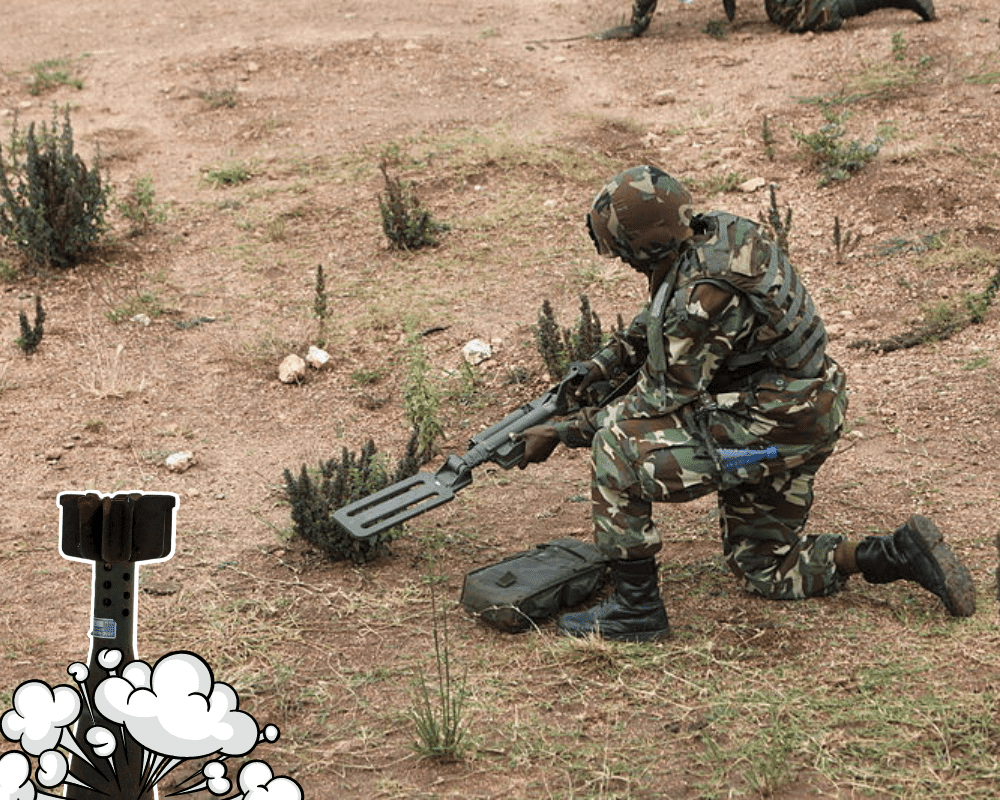
Sappers and pyrotechnicians are soldiers who are tasked with securing suspicious items.
Among other tools, metal detectors are vital in detecting explosive objects by military personnel.
On average, SES specialists isolate and defuse between 2000 and 6000 explosive objects daily.
Although metal detectors aren’t weapons, they’re as crucial as any gun a soldier may carry.
Do you think that’s extreme?
I don’t.
Here are the most prevalent ways a metal detector helps soldiers.
1. Detecting Weapons and Metal Hazards

The most advantageous use of metal detectors for soldiers is finding weapons and metallic threats.
This is applied in three different forms.
The first one is the portable handheld metal detector.
It’s a type of metal detector that soldiers in the military and security guards at concerts, malls, etc., have need of.
For closer inspection, soldiers scan prisoners, refugees, and other individuals by waving these wands over a person’s outline to ensure they’re not hiding knives, guns, or other metal objects that may be used as weapons.
Walk-through metal detectors are a second form of scanning device and are utilized as a further screening tool.
Soldiers generally implement this method as their primary screening instrument. It’s faster than a handheld option and good for larger populations.
In situations like border control and threat assessment to military compounds, a combination of walk-through and handheld metal detectors are used to help soldiers do their job.
The third method for detecting weapons and hazards is a soldier’s use of specialized metal detectors with a stem and armrest, similar to hobby metal detectors.
Soldiers use traditional-style metal detectors to detect bombs planted on walls, on the ground, or in challenging places where excessive debris can conceal precarious metals.
Where hobby metal detectors might confuse regular junk metal in a pile of rubble, military metal detectors have the technology to distinguish between trash and dangerous.
2. Detecting War Mines
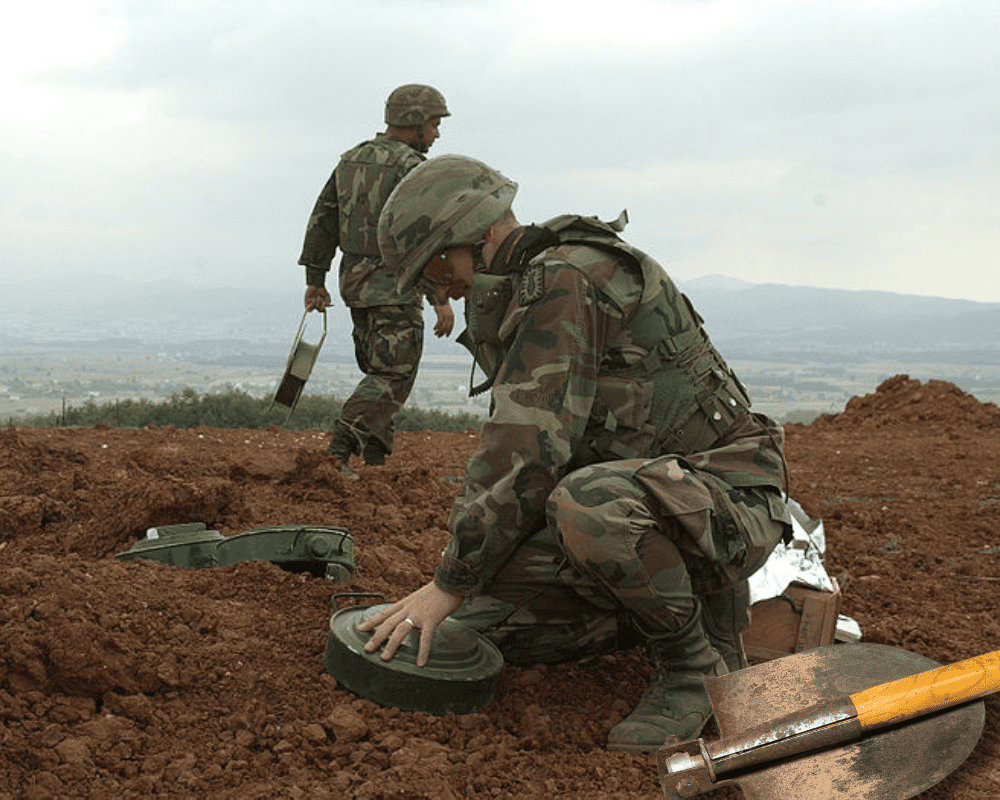
Metal detectors’ most crucial use for soldiers is during wars while detecting landmines.
Landmines are near impossible to find without metal detectors because they’re expertly concealed.
For troops to pass safely through an area with possible landmines, the site must be scanned and demined first.
And this is where metal detectors earn their salt.
Soldiers use them to locate said landmines, so they can clear the area using mine plows and other similar methods.
Essentially, the sapper (soldier detectorist) will search an area carefully, waving the metal detector’s search coil over the terrain.
If the magnetic field emitted from the search coil detects a hazardous metallic device, the metal detector alerts the sapper of its proximity.
3. Humanitarian Demining

Humanitarian demining is no less critical than demining lands during an active war.
After a war ends, possibly even years or decades later, some areas need humanitarian demining. This process removes all landmines and remnants to ensure the zone is safe for human inhabitants.
We just discussed it, but during times of war, soldiers are tasked with clearing paths by detecting and demining explosives.
However, the process is often done in a hurry, so some mines in the area may go undetected. In fact, they often do.
There are often plenty of deeply dug mines that aren’t found until more time is taken for an in-depth search.
On top of that, there may be complete areas that haven’t even been scanned during a war. So it’s necessary for them to go through humanitarian demining afterward to clear the space for civil use.

You see, it’s important to understand that this demining process must be done to a certain depth to deem the area safe. For this reason, it often takes a long time.
Because demining is so dangerous, it’s left to experienced and professionally trained military specialists and bomb experts, recognizable by their camo clothing and state-of-the-art detection tools.
These specialists use technologically advanced metal detectors that send electromagnetic pulses as deep as 20 meters below the ground.
4. Finding Firing Lines
Soldiers don’t only use metal detectors for demining and detecting weapons. There have also been recorded uses for archeological pursuits.
Sometimes military historians look for the enemy’s firing lines and other artifacts using specialized metal detectors.
Early recorded use in the 1940s details Army personnel and local researchers utilizing a form of ground-penetrating radar while investigating the Battle of Little Bighorn site in an unofficial capacity.
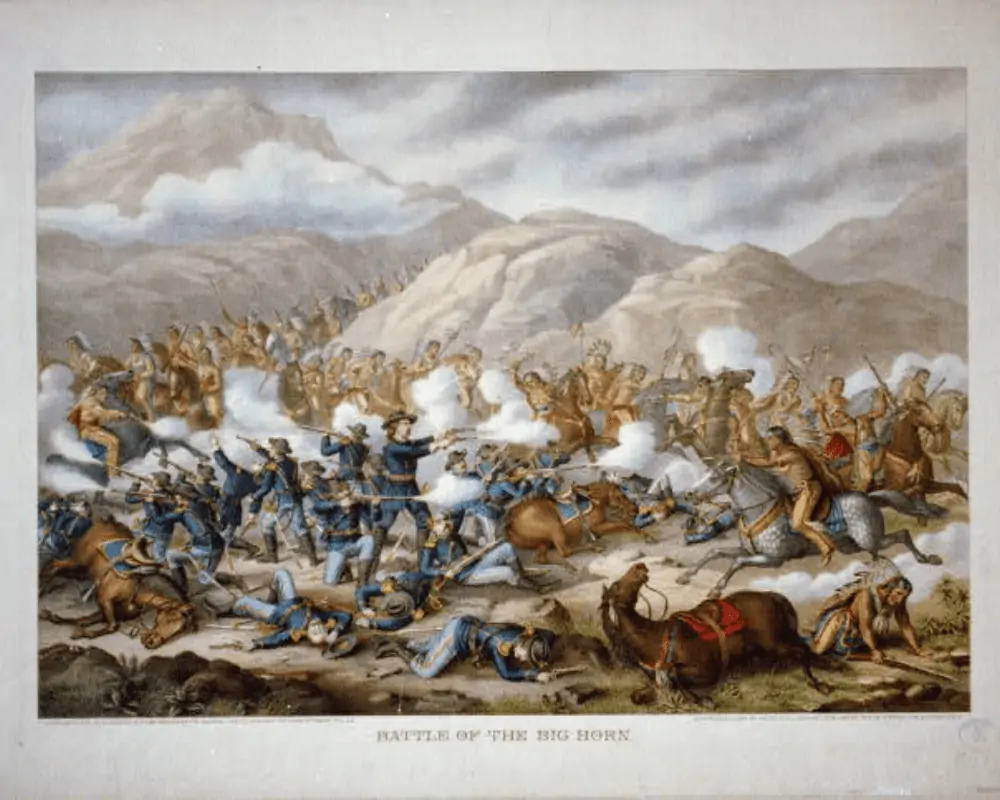
But it wasn’t until 1958 that the first official military use of metal detectors was recorded to map the same site.
Finding the firing lines is paramount for historians to catalog the particulars of military history and strategy so that future generations can learn from them.
When Did the Military First Use Metal Detectors?
Metal detectors were first used by military soldiers during World War II.
Although compact and portable, they were still hard to move around with because of all the heavy attachments (weighing 14kg) and electronic components.
The first metal detector to be used in the war was made by Józef Kosacki, a Polish engineer.

Such detectors were used to clear trails and remove countless landmines.
It’s not a wild statement to suggest that the war’s death toll may have surged if not for them.
Can you imagine if metal detectors had been around for World War I? The entire demining process would have been more efficient and successful.
Over 100+ years since WWI ended, and landmines are still being removed!
Here’s an alarming stat for you…
It’s been reported that roughly 20% of munitions fired during the war never exploded. This means there is a stockpile of lurking dangers buried below the surface.
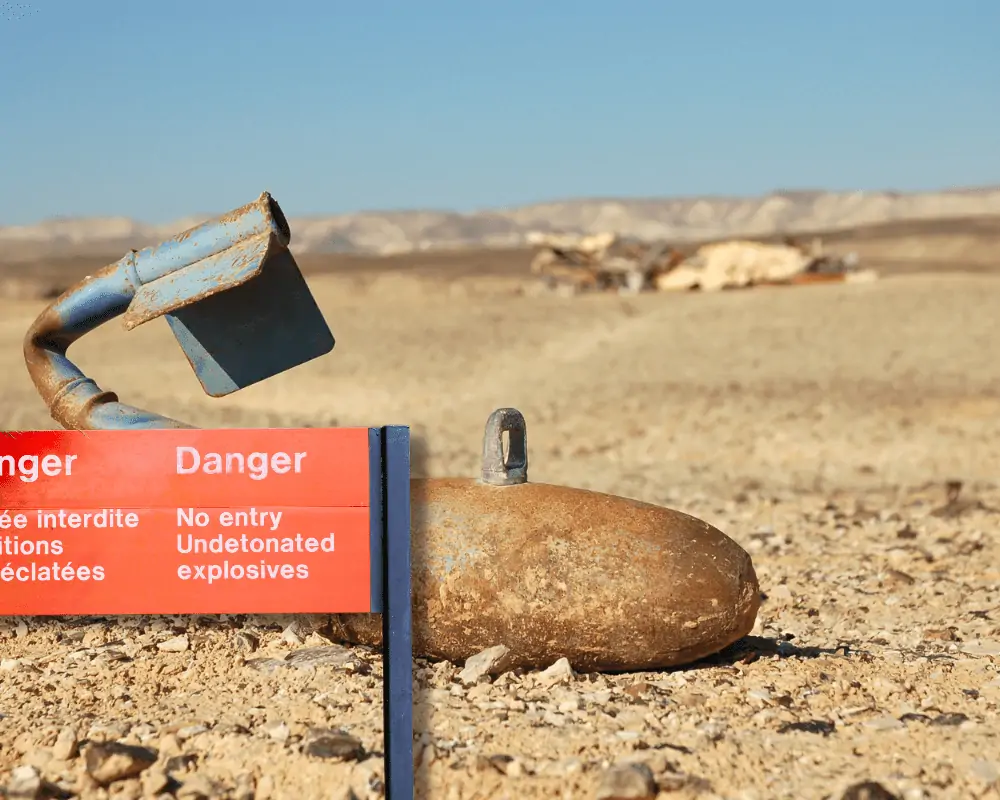
Since soldiers initially used metal detectors in WWII, they’ve become a staple in battles, wars, and post-war pursuits for active landmines.
However, they’re now more advanced, managing to detect metals at deeper depths, and have become more compact for the soldiers’ convenience.
It’s amazing to think how these devices conceivably saved countless lives over the last 80 years of war.
What Are the Different Types of Metal Detectors?
There are three main types of metal detectors.
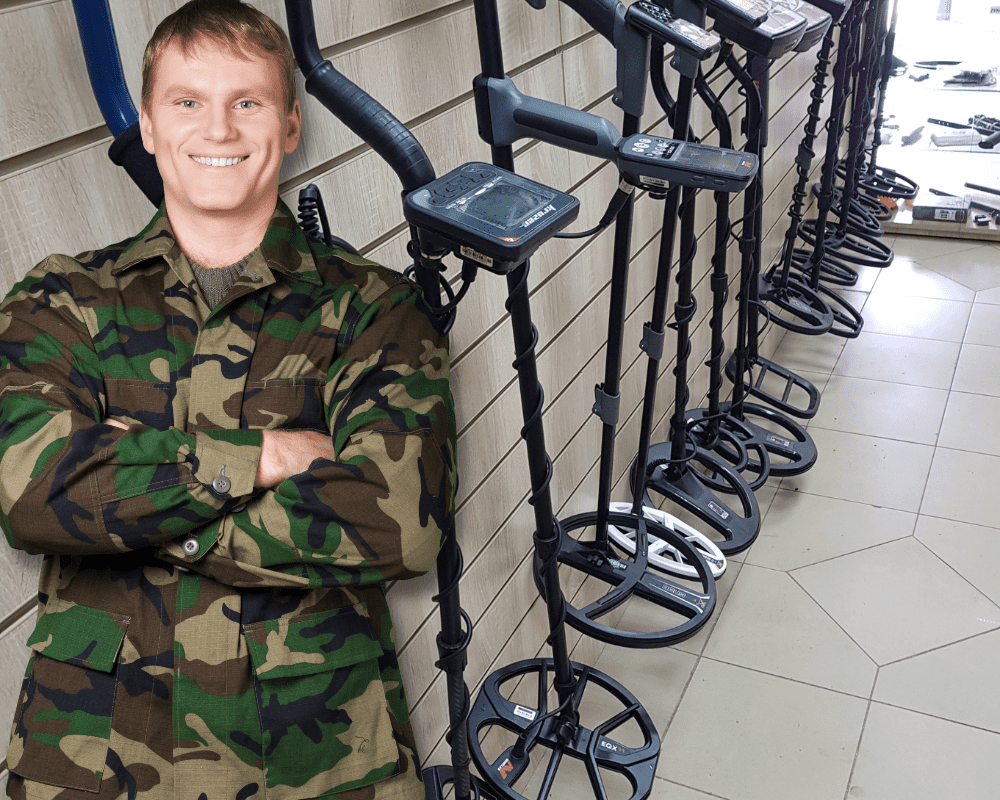
Here’s a roundup:
- VLF Metal Detectors: Very low-frequency metal detectors generally have a fixed frequency for detecting metals. Because it’s low, these detectors are only used for treasure hunting and other general purposes.
- PI Metal Detectors: Pulse induction detectors operate by pulsed signals, which help them detect metals dug deep into the ground. They’re often used by soldiers because of their high frequency.
- FBS Metal Detectors: Full-band spectrum or Multi-Frequency detectors can operate at different frequencies. They can adjust to the everchanging ground conditions, making them advanced enough for military use. However, PI detectors are more common.
What Type of Metal Detectors Do Soldiers Use?
Besides using customary Pulse Induction metal detectors, soldiers also get access to more advanced devices than the average detectorist can experience.

Specifically, soldiers also use technological landmine detectors.
This type of metal detector became popular among soldiers in 2006 when the military began mass production. They operate with ground-penetrating radar (GPR) technology.
But I’ll cover that more momentarily.
Are Hobby Metal Detectors Different From Military Metal Detectors?
Depending on the desired need, hobby metal detectors use much of the same features that military metal detectors use.
But ground-use military metal detectors are built with technology that adds more power, discrimination, targeting prowess, and overall depth.
As for military walk-through metal detectors and handheld wands, they’re no different than those you see at airports or courthouses.

But going back to the distinctions in ground-use or traditional metal detectors, hobbyists use mostly FBS (MI) and VLF metal detectors for everyday dirt fishing.
These tend to be lower in frequency, so they can detect lost relics and valuable metals only a few feet in the soil.
And their discrimination capability is ideal for finding more metals, like your silver wedding ring.
Many hobbyists use pulse induction technology, but often for specific situations like finding gold and detecting underwater.
Military metal detectors use pulse induction for a soldier to get more depth. Or the advanced alternative I mentioned a little bit ago has a GPR-incorporated data fusion algorithm.
An example of the latter is the AN/PSS-14 mine detector which uses a hybrid of data fusion algorithm technology and ground penetrating radar.

“This unique combination enables the system to reliably and consistently detect anti-personnel (AP) and anti-tank (AT) mines and to reject the detection of metallic clutter, increasing operator confidence and efficiency.”
Simply put, this military technology used to help soldiers guarantees a top-of-the-line performance no matter the ground conditions and minimal false alarm interruptions.
While some of the top brands in the industry, like Garrett and Minelab, manufacture both hobby and military metal detectors, the difference between the two is considerable.
That’s why the military pays much more for the performance upgrade.
Final Thoughts

Is it clear now how metal detectors help soldiers?
No one knows how many lives these devices have saved, but you can bet it’s more than we can count.
From detecting dangerous metal objects hidden on highly trained prisoners to demining civilian areas for rehabilitation, metal detectors aren’t any less essential than handheld weapons for military soldiers.
Until next time Diggers…





